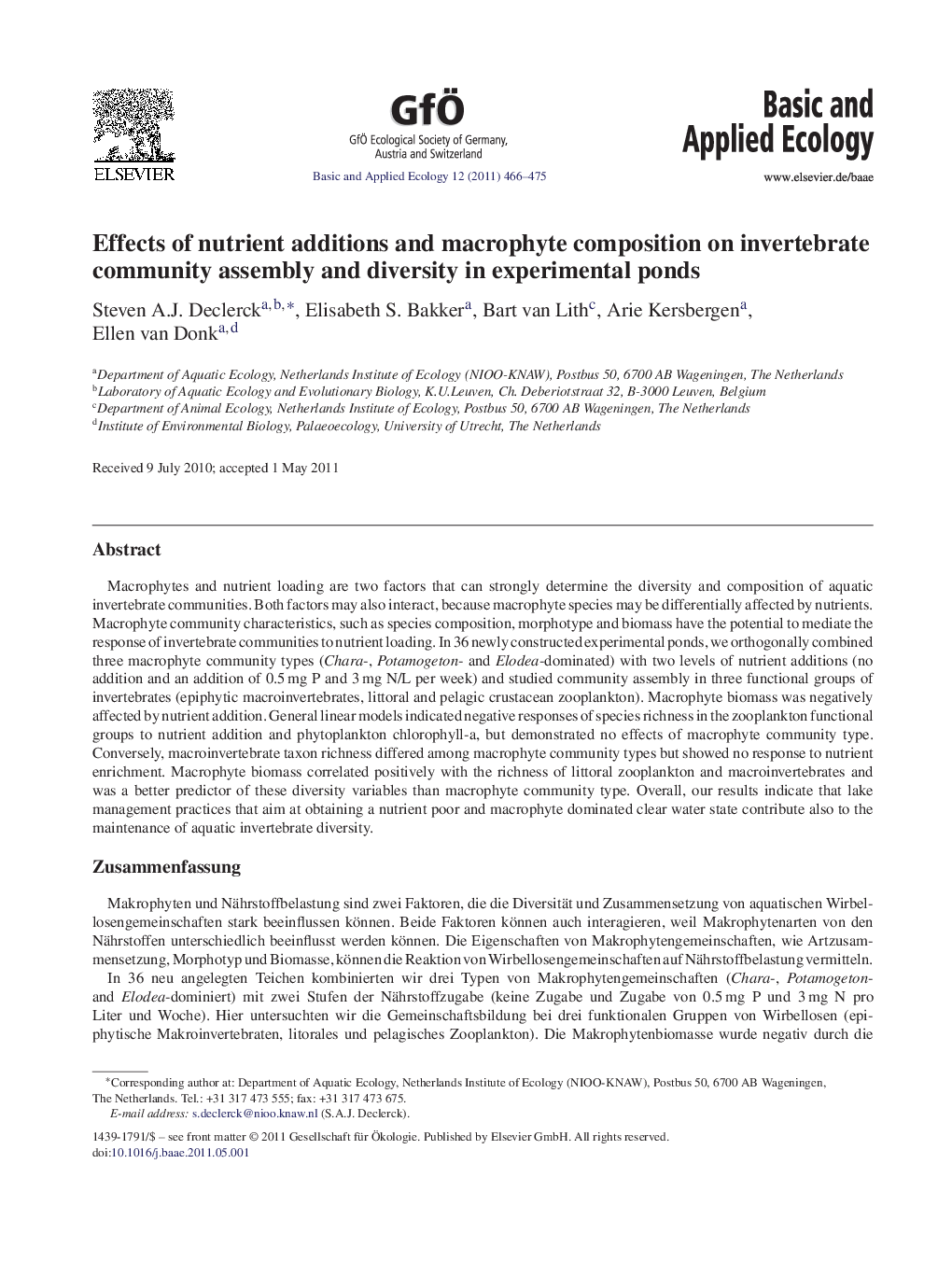| Article ID | Journal | Published Year | Pages | File Type |
|---|---|---|---|---|
| 4384119 | Basic and Applied Ecology | 2011 | 10 Pages |
Macrophytes and nutrient loading are two factors that can strongly determine the diversity and composition of aquatic invertebrate communities. Both factors may also interact, because macrophyte species may be differentially affected by nutrients. Macrophyte community characteristics, such as species composition, morphotype and biomass have the potential to mediate the response of invertebrate communities to nutrient loading. In 36 newly constructed experimental ponds, we orthogonally combined three macrophyte community types (Chara-, Potamogeton- and Elodea-dominated) with two levels of nutrient additions (no addition and an addition of 0.5 mg P and 3 mg N/L per week) and studied community assembly in three functional groups of invertebrates (epiphytic macroinvertebrates, littoral and pelagic crustacean zooplankton). Macrophyte biomass was negatively affected by nutrient addition. General linear models indicated negative responses of species richness in the zooplankton functional groups to nutrient addition and phytoplankton chlorophyll-a, but demonstrated no effects of macrophyte community type. Conversely, macroinvertebrate taxon richness differed among macrophyte community types but showed no response to nutrient enrichment. Macrophyte biomass correlated positively with the richness of littoral zooplankton and macroinvertebrates and was a better predictor of these diversity variables than macrophyte community type. Overall, our results indicate that lake management practices that aim at obtaining a nutrient poor and macrophyte dominated clear water state contribute also to the maintenance of aquatic invertebrate diversity.
ZusammenfassungMakrophyten und Nährstoffbelastung sind zwei Faktoren, die die Diversität und Zusammensetzung von aquatischen Wirbellosengemeinschaften stark beeinflussen können. Beide Faktoren können auch interagieren, weil Makrophytenarten von den Nährstoffen unterschiedlich beeinflusst werden können. Die Eigenschaften von Makrophytengemeinschaften, wie Artzusammensetzung, Morphotyp und Biomasse, können die Reaktion von Wirbellosengemeinschaften auf Nährstoffbelastung vermitteln.In 36 neu angelegten Teichen kombinierten wir drei Typen von Makrophytengemeinschaften (Chara-, Potamogeton- and Elodea-dominiert) mit zwei Stufen der Nährstoffzugabe (keine Zugabe und Zugabe von 0.5 mg P und 3 mg N pro Liter und Woche). Hier untersuchten wir die Gemeinschaftsbildung bei drei funktionalen Gruppen von Wirbellosen (epiphytische Makroinvertebraten, litorales und pelagisches Zooplankton). Die Makrophytenbiomasse wurde negativ durch die Nährstoffzugabe beeinflusst. Bei den funktionalen Zooplanktongruppen zeigten lineare Modelle negative Reaktionen des Artenreichtums auf Nährstoffzugabe und Phytoplankton-Chlorophyll-a, es gab aber keinen Einfluss durch den Typ der Makrophytengemeinschaft. Die Zahl der Makroinvertebratentaxa unterschied sich zwischen den Makrophytengemeinschaften, zeigte aber keine Reaktion auf die Nährstoffanreicherung. Die Biomasse der Makrophyten korrelierte positiv mit der Zahl der Taxa von Makroinvertebraten und litoralem Zooplankton, und sie war ein besserer Prädiktor für diese Diversitätsvariablen als der Typ der Makrophytengemeinschaft. Insgesamt zeigen unsere Ergebnisse, dass Managementmethoden, die auf einen nährstoffarmen, von Makrophyten dominierten, klaren Wasserzustand abzielen, auch zum Erhalt der Diversität von aquatischen Wirbellosen beitragen.
